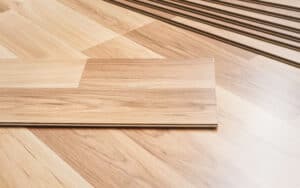
Drywall mud, also referred to as “joint compound,” refers to the material used by contractors and homeowners to provide a flawless and attractive finish as one of the final applications in new drywall installation.
After a project, you may find yourself with extra drywall mud.
While not overly expensive, you still probably don’t want to waste the product, especially if you know you will need it for a drywall installation in the near future.
You can store drywall mud and reuse it at a later date.
However, how long can you store joint compound before it loses its effectiveness or starts to go bad?
How Long Can You Store Drywall Mud?

Unopened drywall mud remains workable for up to a year when properly stored, but many experts suggest using it within nine months to stay on the safe side.
Your drywall mud has a sticker on the container that indicates the shelf life from the manufacturing date code to help you determine how old it is.
These values assume perfect conditions, but the material will expire more quickly when opened or stored improperly.
Unfortunately, expedited decomposition of drywall mud happens often in the DYI community due to a lack of proper storage.
What Is Drywall Mud?

After you put up new drywall, you may notice nail holes, joints, tape, streaks, and other minor imperfections.
Drywall mud covers these blemishes and makes the new wall look smooth and aesthetically pleasing, especially around the corners and areas with the most noticeable flaws.
The drywall mud also helps strengthen the drywall, keeping it sturdy.
Dry Joint Compound Versus Wet Joint Compound

At the hardware store, you can choose between the common dry joint compound or the newer wet joint compound.
Standard containers of both can cover about 1,000 square feet of drywall, often leaving you with leftovers.
Dry joint compound, or “ready-mixed drywall mud,” comes as a powder, and you must mix it with water to create the paste you will apply to the wall.
This option costs less and can potentially last longer, but it requires more know-how from you and the appropriate tools to get the best results.
Wet joint compound or “premixed drywall mud” comes mixed already.
When you get a wet joint compound, you know it was mixed properly, and you get to save the time and effort of doing it yourself.
However, premixed drywall mud costs more, weighs more, and spoils much faster.
**Choose a dry joint compound if you want to store the remaining drywall mud for later.**
Different Types Of Joint Compound

There are different types of drywall mud, depending on your specific needs.
See the following different types of joint compound and their uses:
- All-purpose joint compound: Joint compound that can perform all necessary tasks, such as providing a finish and covering joints. It weighs less than other options, but it takes the longest to dry.
- Taping joint compound: The strongest joint compound that covers cracks and tapes before the final varnish. This joint compound has a dry appearance that makes it inadvisable for the last layer.
- Topping joint compound: Joint compound specifically designed to provide the perfect finish to the drywall. It is known for its smooth texture and appearance.
- Quick-setting joint compound: Joint compound that provides both durability and fast-drying capabilities, making it perfect for the handyman in a hurry. This type of drywall mud does not have the adhesive properties of the other types.
What Makes Up Drywall Mud?

Drywall mud contains living materials, which is why it spoils after time.
Some of the common materials found in drywall mud include the following:
- Ground limestone
- Talcum
- Attapulgite
- Polymer
Is Drywall Mud Safe?

In most cases, joint compound mud doesn’t cause any harm.
However, it depends on the ingredients used in the particular product.
Some drywall mud may contain dangerous materials, such as formaldehyde, that can get into the air you breathe.
When you and your family breathe in the contaminated air, it can affect your respiratory system, your sinuses, and in rare cases, potentially cause cancer.
To keep yourself safe, pay close attention to ingredients in the products you buy, only opting for items with natural ingredients that won’t damage your home’s air quality.
If you must work with toxic drywall ingredients, open the windows and wear a mask.
What Is The Best Way To Store Drywall Mud?

Ideally, you want to store unopened drywall mud in a crisp, dehumidified location.
However, what happens if you want to properly store an already opened container of joint compound?
While it will take a bit of effort on your part, it can be done.
How To Correctly Store Drywall Mud (5 Steps)

Follow these five steps to ensure that you properly store your open joint compound in a way that allows it to remain usable for as long as possible, with the hope of getting the chance to repurpose it for your next drywall undertaking.
Step One: Remove Mud from Outside Container

When applying drywall mud, things can get a little messy.
You may drip on the outside of the drywall mud bucket.
While it may not seem overly critical at first, you need to thoroughly remove any mud from the outside of the container.
Otherwise, this mud can come into contact with negative environmental forces that cause the mud on the outside to go bad and possibly affect the joint compound on the inside of the container.
Step Two: Cover Bucket With Plastic

Next, you need to find a piece of plastic to place over the material in the container.
Many containers come with a piece of plastic, but you can cut your own out of plastic wrap from your kitchen.
If you cut your own piece of plastic, ensure that you completely cover the top of the drywall mud bucket with the plastic so that nothing can come into contact with the material inside of it.
Step Three: Cover Bucket With Bleach Rag

Find a clean rag and dip it into a mixture of two parts water and one part bleach.
When the rag no longer drips, you will place it in a single layer on top of the tight plastic covering.
This bleach rag kills anything that may cause your drywall mud to become damaged and unusable.
Step Four: Secure The Lid

Now, you will put the lid back onto the joint compound bucket.
You will use a hammer or another blunt object to create the tightest closure you can.
If you don’t get as tight of a seal as you want, consider using additional materials to enhance the lid’s effectiveness.
You can also put the container into a tied bag.
Step Five: Avoid Storing In Hot, Moist Locations

Avoid warm, humid spaces when picking a place to store your drywall mud since these conditions breed living things.
Instead, try a place with a lower temperature than the rest of your property, such as a basement.
You also don’t want the area to have high levels of moisture, so avoid plumbing and parts of your home that create condensation.
If your home experiences high moisture levels, consider investing in a dehumidifier, not only to properly store your drywall mud but to increase comfort and promote proper sinus health.
Moldy Drywall Mud

The main thing you will notice when drywall goes bad is the new development of mold.
Drywall mud contains organic materials.
When these organic materials start to deteriorate, it provides sustenance for mold.
As mold develops, it feeds off of the drywall mud.
The peptic proteins produced by the mold slowly break down the joint compound.
Why Is Mold So Dangerous?

Besides looking and smelling unappealing, mold can carry a devastating impact.
Some people may not worry about minute levels of mold growth and use the drywall mud anyway to save a couple of dollars.
However, these savings can cost those people later.
Mold continues to grow when given the opportunity.
Once you have mold, it continues to grow at alarming rates and starts to damage the surfaces and items around it, too.
Eventually, you will need to pay for extensive mold removal services and costly repairs to your home.
Furthermore, mold spores get into the air.
Some mold spores, particularly those from black mold, can cause health problems when we breathe it in heavy concentrations.
The longer the exposure to the mold spores in the air, the more likely you will experience serious medical conditions.
How Can I Minimize Mold Formation?

If you want to minimize the likelihood of mold forming, you need to start by learning the conditions that lead to mold growth.
The following factors work together to create a hotbed for rapid mold germination:
- Temperatures between 77°F and 86°F
- High humidity levels
- Moisture
- Nourishment (drywall mud)
Now that you know what creates mold, you can take action to create an unfavorable situation for mold development (outside of proper storage).
1. Buy Dry Joint Compound
Set yourself up for long-term storage from the beginning by purchasing dry joint compound.
Moisture contributes to the development of mold, so wet joint compound grows mold far more quickly.
2. Buy Smaller Containers
If you keep finding yourself with moldy joint compounds, you should look for smaller containers in the future and do your best to use up the materials you have.
3. Schedule Drywall Installation Quickly
If you know you have upcoming drywall work to do, move it up as quickly as you can in your schedule.
While drywall mud can last nine to 12 months in perfect conditions, you will benefit from using it before it sits out for that long.
What Do I Do If I Find Moldy Drywall Mud?

First and foremost, do not use moldy drywall mud under any circumstances!
You will notice the mold right away based on the appearance of the mold on the joint compounds well as the musty smell.
Do not think that you can salvage the material seemingly not touched by the mold yet.
At this point, you will need to cut your losses and buy new drywall mud.
Conclusion

In an ideal environment and properly cleaned and secured, dry joint compound can last up to 12 months from the date code on the sticker on the bucket.
However, made out of living material, drywall mud becomes susceptible to mold growth especially quickly.
Luckily, you can take the appropriate steps to store drywall adequately, reducing the likelihood of mold formation ruining your construction materials.
If you do find yourself with moldy drywall mud, throw it out before you end up with moldy walls.




Leave a Reply